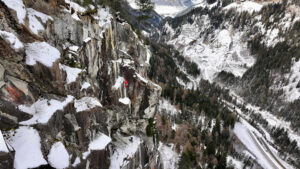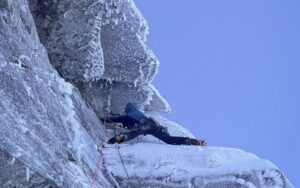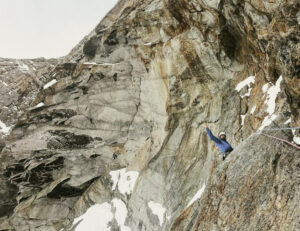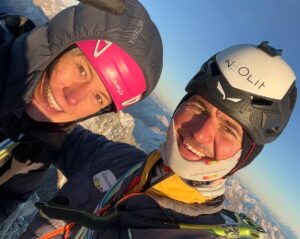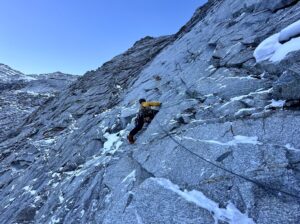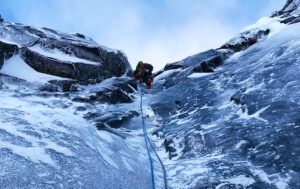On Saturday, November 20, 2021, alpinists Francesco Civra Dano and Giuseppe Vidoni nabbed the first ascent of a virgin ice climb on Mont Blanc’s east-facing Brenva wall. In doing so, the two Italians made a new and historic contribution on hallowed mountaineering ground.

Photo: Giuseppe Vidoni
‘Cascata Major’ and its place in Mont Blanc history
They dubbed the icefall Cascata Major and gave it a general grade of VI / WI 5. Located between Brenva’s Major and Poire routes, the cascading Cascata Major takes root near the 4,000m mark and shoots up a freshly frozen spout for 170 vertical meters. A traverse and scramble lead up to the ice feature; a series of technical directs, scrambles, and traverses follow it. From base to summit, the route spans 1,300m.
In his field report, Vidoni notes that the Brenva wall is Mont Blanc’s Himalayan face, “hosting some of the most beautiful and demanding routes in the Alps, such as the Brenva Spur, the Sentinella Rossa, the Via Major, the Poire. It’s immensely fascinating, but also highly dangerous wall because of the huge seracs that loom above the face.”
The Italian duo set out from their bivy in the wee hours of November 20. They took advantage of the full moon in deciphering their uncharted approach to the frozen fount’s base. They arrived at dawn, racked up, and began climbing grade V immediately.
The ice feature encases a straight and vertical granite pillar from start to finish, giving the climbers very few opportunities to rest along the way. After 170m of continuous effort, Dano and Vidoni came to a snow slope.

Photo: Giuseppe Vidoni
Burning calves
Contrary to their initial impression, the slope proved deceptively challenging. “It forced us to front point continuously because of the layer of ice hidden 15cm below the snow,” Vidoni reported. “With burning calves, we reached the base of the last pillar and finally managed to rest and drink the last drop of water.”
To reach Mont Blanc’s summit, they needed to access the peak’s Col Major. Although less vertical than the lower pitches, traversing the route’s final pillar, with its bounty of seracs and steep slopes, required technical and athletic precision. They opted to take this challenging but efficient direct line to Mont Blanc’s summit. They reached it and ticked a proud first ascent before sundown.
Nearly 250 years ago, the early iteration of modern alpine mountaineering was born atop Mont Blanc. Since that time, countless mountaineers have followed, peppering almost every bit of the massif’s topography with routes. Almost.
What remains unclimbed today is largely written off as intractable, undesirable, or a bit of both. To envision and successfully establish a new line on Mont Blanc today might seem absurd, but Dano and Vidoni have proven that it is not impossible.

